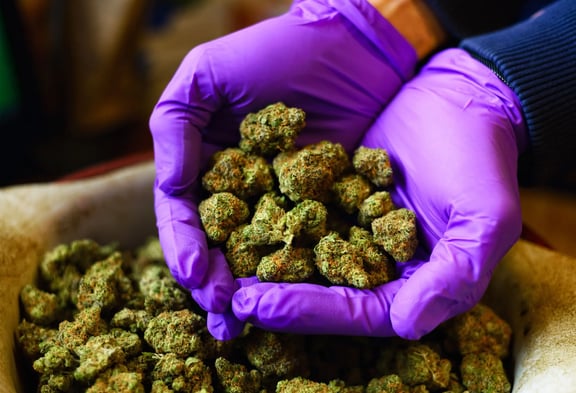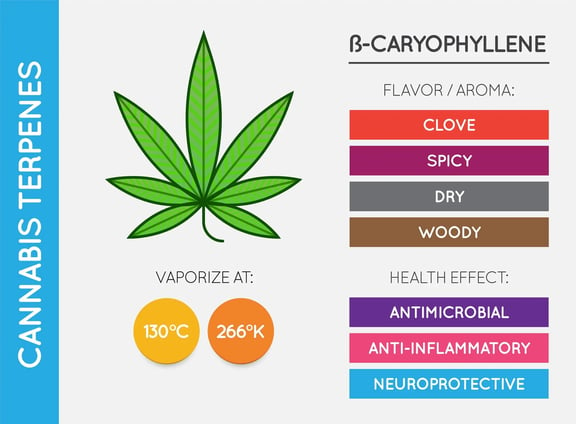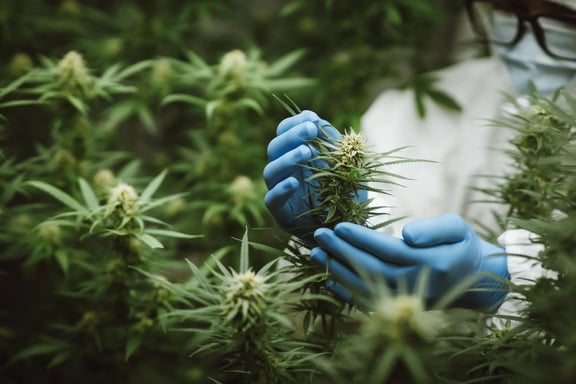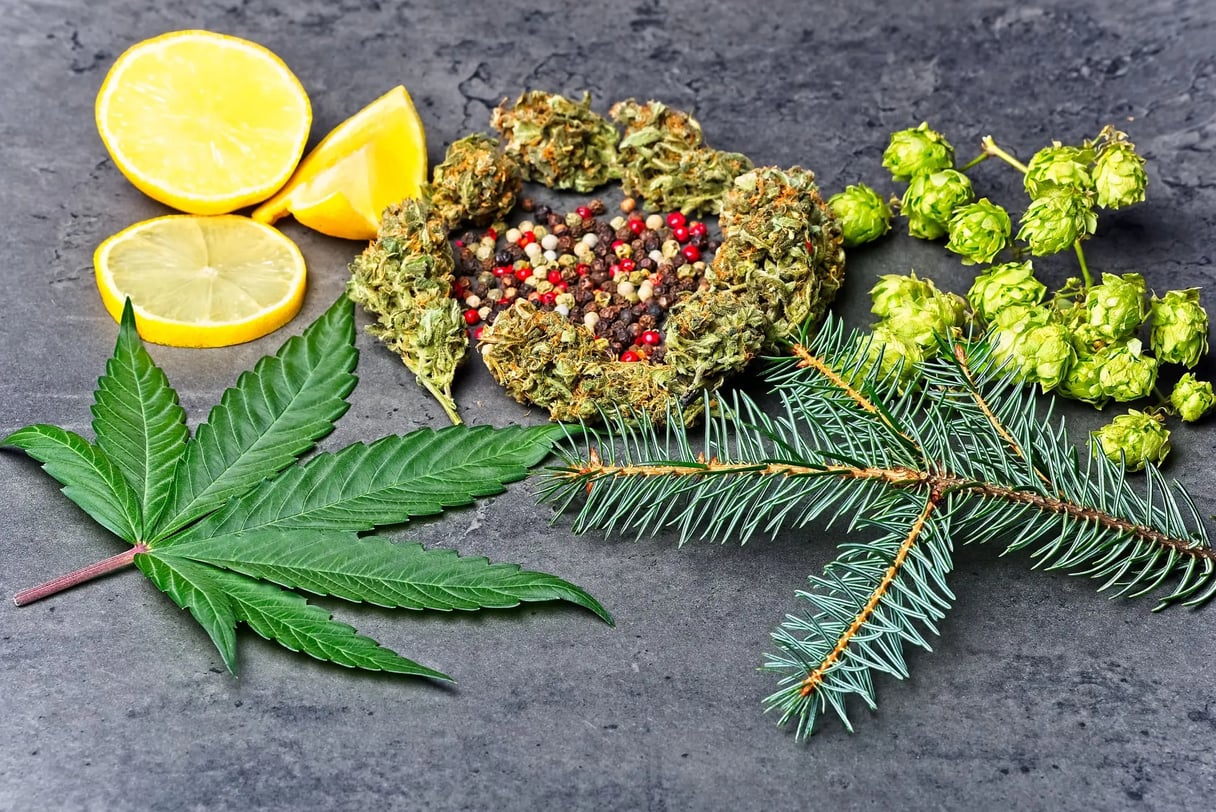Introduction
In the labyrinthine world of weed strains, Caryophyllene stands as a terpene of many faces. It’s not just another aromatic compound that gives your favourite strain its spicy kick; it’s a complex character with a role that extends far beyond mere scent. Caryophyllene is a bit of an enigma, a terpene that also acts like a cannabinoid. Its unique ability to interact with the endocannabinoid system sets it apart from its terpene siblings, making it a subject of intense scientific scrutiny and growing popular interest.
As we delve into the multifaceted realm of Caryophyllene, especially Caryophyllene as a cannabis terpene, we’ll explore its unique molecular structure, its prevalence in various cannabis strains, and its broader applications in food, medicine, and beyond.
This article aims to be your comprehensive guide to understanding Caryophyllene, especially its role in the medical cannabis world. We’ll traverse its scientific classification, its aroma characteristics, and its interaction with the endocannabinoid system. We’ll also delve into its prevalence in different cannabis strains and its role in the entourage effect. So, whether you’re a cannabis connoisseur looking to deepen your understanding or a curious reader, buckle up for a journey into the fascinating world of Caryophyllene—a terpene that’s as complex as it is intriguing.

Unveiling Caryophyllene: A Unique and Complex Terpene
Molecular Structure
Caryophyllene is no ordinary terpene. Its molecular structure is a marvel, featuring a rare cyclobutane ring not found in other known cannabis terpene. “Caryophyllene is a bigger molecule than terpenes like myrcene and limonene. Caryophyllene’s molecular structure also contains a cyclobutane ring, something rare in nature and not found in any other known cannabis terpene,” – Source. This unique structure allows it to interact with our endocannabinoid system, setting the stage for a host of potential health benefits we’ll explore later.
Scientific Classification
When it comes to scientific classification, Caryophyllene belongs to the class of sesquiterpenes, which are composed of three isoprene units. This makes it a larger and more complex molecule compared to monoterpenes like myrcene and limonene. Its full name, Beta-Caryophyllene, often abbreviated as BCP, gives a nod to its scientific complexity. The ‘Beta’ signifies its form that is most abundant in cannabis, among other plants. This complexity is not just for academic admiration; it has practical implications, especially in how Caryophyllene interacts with cannabinoids in the cannabis plant to produce what is known as the entourage effect.
The Nature of Caryophyllene
Origin and Natural Occurrences
Caryophyllene is a worldly traveller, making appearances in a variety of plants beyond cannabis. It’s found in herbs and spices like black pepper, basil, and oregano. However, its role in cannabis is particularly noteworthy. In cannabis, Caryophyllene is often found in strains that have a spicy, woody aroma. It’s one of the more abundant terpenes in many cannabis strains, contributing not just to the plant’s scent profile but also to its therapeutic properties.
Aroma Characteristics: The Spicy Undertone
If you’ve ever been captivated by the spicy, peppery aroma of a cannabis strain, you’ve likely encountered Caryophyllene. This terpene is the maestro behind those warm, woody, and spicy notes that make certain cannabis strains so inviting. “Caryophyllene’s unique molecular structure allows it to bind to endocannabinoid receptors (CB1 and CB2 receptors) — providing many additional benefits most other terpenes can’t offer,” – Source. This aromatic profile isn’t just for sensory pleasure; it’s a clue to the terpene’s unique ability to interact with our endocannabinoid system, offering potential benefits beyond aroma.

Caryophyllene’s Interaction with the Endocannabinoid System
Functional CB2 Receptor Agonist
Caryophyllene isn’t just another face in the crowd of cannabis terpenes; it’s a functional CB2 receptor agonist. This means it can directly interact with the endocannabinoid system, much like cannabinoids such as THC and CBD. “Beta-caryophyllene selectively binds to the CB2 receptor and shows significant cannabimimetic anti-inflammatory effects in mice,” – Source. This unique ability opens up a realm of therapeutic possibilities, making Caryophyllene a subject of keen scientific interest.
Therapeutic Implications
The therapeutic implications of Caryophyllene’s interaction with the endocannabinoid system are vast. Its anti-inflammatory and analgesic properties have been studied, offering a natural alternative for pain relief and inflammation control. “Caryophyllene oxide, a component of the essential oils of rosemary and cannabis, has been approved by the FDA for use as a food additive and is used in fragrances,” – Source. This FDA approval hints at its safety profile, making it a promising candidate for future pharmacological applications.
Caryophyllene in Cannabis
Prevalence in Different Strains
When it comes to cannabis, Caryophyllene takes centre stage in many popular strains. It’s particularly abundant in strains that exude a spicy, peppery aroma. “Strains high in caryophyllene deliver a strong spicy, peppery aroma, reminiscent of cinnamon and cloves,” – Source. This prevalence isn’t just a sensory delight; it’s a clue to the terpene’s therapeutic potential, especially when it comes to the entourage effect in cannabis.
The Entourage Effect: Caryophyllene’s Role
The entourage effect in cannabis is a synergistic interaction between cannabinoids and terpenes, enhancing the plant’s overall therapeutic benefits. Caryophyllene plays a significant role in this phenomenon due to its unique ability to interact with the endocannabinoid system. “Caryophyllene contributes to the spiciness of black pepper and is a major part of clove oil, rosemary, and hops,” – Source. Its presence amplifies the effects of other cannabinoids, making it a key player in the cannabis entourage effect.
Identifying High-Caryophyllene Strains
If you’re hunting for high-Caryophyllene strains, your nose might be your best guide. The spicy, peppery aroma is a dead giveaway. But don’t rely on your olfactory senses; lab-tested products often provide terpene profiles that can guide you in your quest. Strains like GSC, Original Glue, and Purple Punch are known for their high Caryophyllene content, offering not just a unique aroma but also a range of potential health benefits.
Beyond Cannabis: Caryophyllene’s Broad Spectrum
Caryophyllene in Culinary Spices
Caryophyllene’s influence isn’t confined to the cannabis world; it’s a star player in your spice rack too. Found in black pepper, cloves, and cinnamon, it’s what gives these spices their characteristic kick. “Caryophyllene is the primary terpene that contributes to the spiciness of black pepper and also a major terpene in cloves, hops, rosemary, and even some strains of cannabis,” – Source.
From Basil to Oregano: Diverse Sources of Caryophyllene
The terpene’s versatility doesn’t stop at your spice rack; it extends to herbs like basil and oregano. Its presence in these herbs contributes not only to their aromatic profile but also to their therapeutic properties. “In addition to showing up in various herbs and spices, caryophyllene is present in many plants we don’t typically think of as aromatic, like black caraway, lavender, and rosemary,” – Source. This makes Caryophyllene a ubiquitous terpene, marking its territory across a broad spectrum of flora.
Caryophyllene in Traditional Medicine
Historical Uses
Caryophyllene has been a staple in traditional medicine for centuries, particularly in cultures that heavily utilise spices like black pepper and cloves. “In traditional medicine, caryophyllene-rich plants such as clove, cannabis, and black caraway have been used for millennia to treat a variety of medical disorders such as anxiety and depression,” – Source. Its historical uses span from anti-inflammatory remedies to treatments for ulcers and pain relief, showcasing its versatile therapeutic potential.
Modern-Day Applications
Fast forward to today, and Caryophyllene is making waves in modern medicine. Its unique ability to interact with the endocannabinoid system has opened new avenues for research and therapeutic applications. “Caryophyllene is a common dietary phytocannabinoid that selectively activates the CB2 receptor and provides long-lasting relief from inflammatory pain,” – Source. This has led to its inclusion in various pharmacological products to treat chronic pain and inflammation.

The Healthful Promises of Caryophyllene
Anti-inflammatory Potential
Caryophyllene’s anti-inflammatory potential is one of its most promising therapeutic attributes. “Beta-caryophyllene is a dietary cannabinoid that selectively activates the CB2 receptor and shows significant cannabimimetic anti-inflammatory effects in mice,” – Source. This anti-inflammatory action makes it a subject of interest in the treatment of conditions like arthritis and Crohn’s disease, especially within the context of cannabis-based therapies.
Analgesic Properties: A Natural Pain Reliever?
Regarding pain relief, Caryophyllene offers a natural alternative that’s capturing the attention of both researchers and consumers. “Caryophyllene oxide has the distinction for being the component responsible for cannabis identification by drug-sniffing dogs,” – Source. This speaks volumes about its prevalence in cannabis strains known for their analgesic effects.
Anti-Anxiety and Antidepressant Prospects
The terpene’s interaction with the endocannabinoid system also offers potential anti-anxiety and antidepressant effects. “Caryophyllene’s strong affinity to the CB2 receptor makes it an attractive candidate for anti-inflammatory, analgesic, anti-anxiety and anti-depressant drugs,” – Source. This makes Caryophyllene a multi-faceted terpene with a range of mental health applications, further solidifying its role as a key player in cannabis therapeutics.

Caryophyllene in Animal Studies
Key Findings
Animal studies have been a cornerstone in unravelling the therapeutic potential of Caryophyllene. Research has primarily focused on rodents, revealing significant anti-inflammatory and analgesic effects. “In animal models, caryophyllene has demonstrated anti-inflammatory, antioxidant, and pain-relieving abilities,” – Source. These studies have been pivotal in understanding how Caryophyllene interacts with CB2 receptors, offering a glimpse into its potential as a non-psychoactive therapeutic agent. The terpene’s ability to mitigate pain and inflammation in animal models has opened up new avenues for research, particularly in the context of chronic conditions that are notoriously difficult to manage.
Implications for Human Health
The implications of these animal studies for human health are far-reaching. “The anti-inflammatory, cytoprotective, and anti-carcinogenic effects of caryophyllene can be attributed to its selective agonistic action on the CB2 receptor,” – Source. These findings are not just academic; they lay the groundwork for future human trials and potential medical applications. The data gathered from animal studies is crucial for understanding dosage, efficacy, and safety, particularly in the realm of cannabis therapeutics. The hope is that these preliminary findings will pave the way for more targeted therapies for a range of conditions, from chronic pain to inflammatory disorders.
User Testimonials and Anecdotal Evidence
Cannabis Users
Anecdotal evidence from cannabis users often highlights Caryophyllene’s calming and pain-relieving effects. “Users often report a sense of relaxation and mental clarity,” – Source. This user feedback aligns with the terpene’s known interaction with the endocannabinoid system, particularly its affinity for CB2 receptors. These personal testimonials serve as real-world evidence of Caryophyllene’s efficacy, often corroborating the findings from scientific studies. While anecdotal evidence should not replace rigorous scientific inquiry, it does provide a valuable perspective, particularly for those interested in the practical applications of Caryophyllene in cannabis.
Traditional Medicine Practitioners
Traditional medicine practitioners have long touted the benefits of Caryophyllene-rich plants like black pepper and cloves. “It’s commonly used in traditional medicine for its anti-inflammatory and analgesic properties,” – Source. These anecdotal accounts serve to bolster the scientific research, offering a holistic view of Caryophyllene’s therapeutic potential. The wisdom of traditional medicine often serves as a starting point for scientific investigation, and in the case of Caryophyllene, it has provided valuable insights into its diverse applications. From pain management to anti-inflammatory treatments, traditional medicine practitioners offer a wealth of knowledge that complements scientific research.
Environmental Impact
Production and Extraction
The production and extraction of Caryophyllene are often overlooked aspects with significant environmental implications. The terpene is commonly extracted from botanical sources like black pepper, cloves, and of course, cannabis. The extraction methods can vary, but steam distillation is commonly used. While this method is relatively eco-friendly, the cultivation of these plants can have varying environmental impacts. For instance, cannabis cultivation is known for its high water usage, which can be a concern in areas suffering from water scarcity. Moreover, using pesticides and fertilisers in cultivation can lead to soil and water pollution. “The environmental impact of terpene extraction has been a subject of study, focusing on energy consumption and solvent use,” – Source. Therefore, sustainable practices in the production and extraction of Caryophyllene are crucial for minimising environmental damage.
Sustainability Concerns
Sustainability is a growing concern in the world of terpenes and essential oils. The demand for Caryophyllene, especially in the food and pharmaceutical industries, is rising. This increasing demand puts pressure on natural resources, leading to over-cultivation and potential depletion of certain plant species. Sustainable farming practices and responsible extraction methods are therefore essential. “Sustainable production of terpenes is an ongoing research area, focusing on using waste biomass as a starting material,” – Source. The move towards more sustainable methods is not just an environmental necessity but also a potential marketing point for companies in the ‘green’ consumer market.

Legal Status and Regulations
In the United Kingdom, the legal framework surrounding cannabis and its components is a complex tapestry, but Caryophyllene enjoys a somewhat simpler status. Unlike THC, the psychoactive component of cannabis, Caryophyllene is not listed as a controlled substance under the UK Misuse of Drugs Act. This is a significant point, as it allows for greater freedom in researching and utilising this particular terpene for various applications, including therapeutic ones.
The absence of Caryophyllene from the list of controlled substances in the UK provides a unique opportunity for researchers, clinicians, and consumers. It means that studies can be conducted, and products can be developed without the stringent legal restrictions that often accompany substances derived from cannabis. This is particularly noteworthy given that medical cannabis flower and products were only legalised in the UK in 2018 and is still subject to tight regulations and prescription guidelines. Recreational cannabis, on the other hand, remains illegal.
Caryophyllene’s legal status also has implications for the burgeoning UK cannabis industry, which is increasingly focusing on the medical and wellness sectors. Because Caryophyllene is found in other legal plants like black pepper, cloves, and rosemary, it can be extracted and used in a variety of products ranging from essential oils to food supplements. This opens up a plethora of opportunities for businesses and consumers alike, all within the bounds of UK law.
In essence, the legal standing of Caryophyllene in the UK offers a promising avenue for scientific research and commercial development. It allows for this fascinating terpene to be explored and potentially integrated into a range of treatments and products without the legal complications that often come with cannabis-related substances.
Do I need a medical cannabis card to get a prescription in the UK?
No, in the UK, medical cannabis cards are not a legal requirement for obtaining a prescription. However, patients will need to see a specialist doctor who is registered with the General Medica Council (GMC) and is on the Specialist Register. This doctor will assess the patient's medical history and determine if they meet the criteria for a cannabis-based treatment.
However, some private medical cannabis clinics do offer patients medical cannabis cards for their convenience. These cards can be used as proof of the individual's status as a legal medical cannabis patient in the UK
Scientific Inquiries and Future Directions
Current Research Landscape
The current research landscape for Caryophyllene is both exciting and challenging. While there have been significant strides in understanding its therapeutic potential, much remains to be discovered. “Recent studies have focused on its potential anti-inflammatory and analgesic properties,” – Source. However, most of these studies are either in vitro or animal-based, leaving a gap in human clinical trials. The need for more comprehensive studies is evident, especially to understand the terpene’s interaction with other cannabinoids and its long-term effects.
Uncharted Territories: What More to Uncover?
As we venture into the uncharted territories of Caryophyllene research, several questions remain unanswered. Its interaction with the endocannabinoid system, particularly the CB2 receptors, opens up a plethora of research avenues. “The selective binding of Caryophyllene to CB2 receptors is a subject of ongoing research,” – Source. Moreover, its potential applications in treating mental health issues like anxiety and depression are still largely untapped. The terpene’s role in the entourage effect, especially in enhancing the therapeutic properties of cannabinoids, is another area ripe for exploration.
Summary
In the fascinating world of cannabis and terpenes, Caryophyllene stands out as a unique and complex compound with a myriad of potential applications. From its intriguing molecular structure to its significant role in the cannabis entourage effect, Caryophyllene is a terpene that demands attention. Its presence is not limited to cannabis; it’s found in everyday culinary spices and has a long history in traditional medicine.
The scientific community is abuzz with research on its therapeutic potential, from anti-inflammatory and analgesic properties to promising anti-anxiety effects. However, the journey of Caryophyllene research is far from over, with many uncharted territories awaiting exploration. As we move towards more sustainable production and extraction methods, Caryophyllene’s role in the cannabis industry and beyond is set to grow, offering a wealth of opportunities for both consumers and researchers alike.
Caryophyllene FAQs:
-
Caryophyllene is a terpene found in various plants, including cannabis. It’s known for its spicy aroma and potential therapeutic benefits.
-
Yes, Caryophyllene itself is not a controlled substance in the UK, although cannabis laws may apply if it’s sourced from that plant.
-
Caryophyllene is commonly found in black pepper, cloves, and cinnamon.
-
No, Caryophyllene does not have psychoactive effects as it binds primarily to the CB2 receptors.
-
Research suggests it may have anti-inflammatory, analgesic, and anti-anxiety properties.
-
While generally considered safe, it’s always best to consult with a healthcare provider for personalised advice.
-
Yes, it’s often found in culinary spices like black pepper and cloves, adding a spicy kick to dishes.
-
It’s believed to play a role in the cannabis entourage effect, potentially enhancing the therapeutic effects of other cannabinoids.
-
Sustainable farming practices are encouraged as the demand for Caryophyllene grows, to minimise environmental impact.
-
Caryophyllene can be found in various essential oils, food products, and cannabis-based products, available in stores and online.












.jpg)